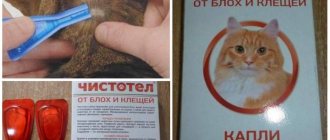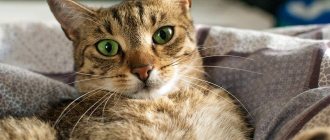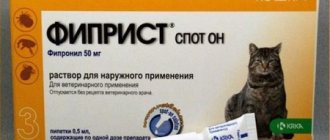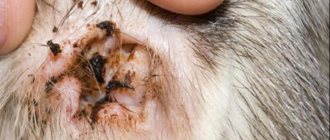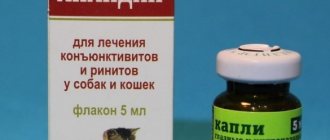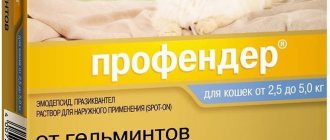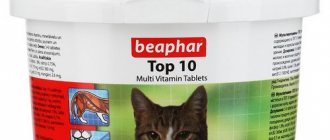Insects that parasitize a pet’s body can cause inconvenience not only to the animal, but also to humans. During a bite, bloodsuckers can cause an allergic reaction or infect the victim with various infections.
Cat flea spray helps to quickly and effectively deal with the problem even in conditions of highly infested areas.
Despite all the advantages of choosing, the drug is toxic and needs to be used correctly, so before purchasing you need to carefully read the instructions and contraindications.
Operating principle and effectiveness of flea drops for cats
Flea drops for kittens and adult cats are a concentrated insecticidal solution based on plant or chemical components that destroy most external parasites. Anti-flea drops also contain additional ingredients that promote faster absorption of the active ingredients of the drug into the cat’s skin.
Flea drops on the withers are distributed evenly over the pet’s skin, penetrate the hair follicles, sebaceous glands, skin and subcutaneous fat, and then the following happens:
- When a flea comes into contact with the drug, it is absorbed into the chitinous cover of the insect.
- The active substance affects the central nervous system of fleas and leads to muscle paralysis.
- The parasite loses the ability to feed, move and soon dies.
- Insecticides do not penetrate the circulatory system, but are broken down in the animal’s skin into substances that are safe for health and then removed from the body naturally.
Most often, cat flea medications contain the following active ingredients of synthetic origin:
- Phenylpyrazole, fipronil. Anti-parasite products containing these active ingredients are safe for the health of cats and have a wide spectrum of action. They affect the central nervous system of insects and also provide protection against piroplasmosis. Such insecticides have a long-lasting effect because they accumulate in the sebaceous glands.
- Diflubenzuron. Insecticides with this component prevent the proliferation of parasites and, accordingly, reduce their number in the cat. Diflubenzuron blocks the formation of chitin in fleas, destroys larvae or prevents their formation from eggs.
- Imidacloprid. Imidacloprid belongs to the class of neonicotinoids. It enters the flea's body through ingestion or direct contact, and then suppresses the nervous system and leads to paralysis. After using the drug with this active ingredient, most fleas die within 12 hours.
- Ivermectin. Ivermectin is very toxic and must be used with extreme caution. It paralyzes the central nervous system of fleas and causes their muscles to relax, as a result of which the parasites lose the ability to feed and die.
- Diazinon. This active substance is highly toxic, which means that preparations containing it are prohibited for use on kittens. Diazinon penetrates the flea's body through cell membranes, blocks nerve impulses and leads to its death.
- Methoprene, pyriproxyfen. These substances block the development of fleas: they prevent the transformation of larvae into pupae, kill eggs, and have a sterilizing effect on the imago.
Interesting! The most effective remedies for parasites due to the combined effect on them are considered to be those that contain several active ingredients at once.
In addition to chemical components, flea products for cats may also contain natural substances: extracts of aloe, eucalyptus, tansy, ginseng and various essential oils. Their smell repels insects, but such preparations are not capable of destroying insects. In addition, they can cause allergies.
Side effects
All prophylactic drugs intended to combat parasites are toxic. Drops released for treating kittens are usually classified as moderately toxic substances. It is important to understand that the conditional safety of the drops implies exclusively external use and the absence of an individual allergic reaction.
If you are treating a kitten with an unknown medical history, you should use the safest possible drops and consult your veterinarian first. In most cases, kittens picked up on the street or bought at a poultry market are infected not only with fleas, but also with worms. In case of mixed invasion, it is much more reasonable to use complex drugs (for external and internal parasites) in the form of drops.
Kitten itches after flea drops
In rare cases, if there is an individual intolerance to the active ingredients of the drops, the animal may experience an allergic reaction. If the kitten itches after flea drops, it is necessary to inspect the treatment area. Alarming symptoms are: redness, swelling and local fever. If you notice symptoms of an allergic reaction, the remaining droplets must be washed off from the kitten’s fur and skin.
In the absence of an allergic reaction, after treatment with drops, the kitten may itch during the day. The fact is that most drops quickly paralyze fleas, but the death of parasites can occur within several hours. An allergic reaction to already inflicted flea bites can last up to 12–20 hours. In addition, gentle drugs can only affect adults. In this case, the treatment is repeated after 4–10 days (according to the instructions or prescription of the veterinarian).
In what cases do veterinarians recommend using drip medications?
Drops against fleas, ticks and worms for cats are the most effective and safe means for getting rid of parasites and preventing their occurrence. Thanks to this form, they are quickly absorbed into the skin of furry pets and evenly distributed throughout the body. After consuming blood with an insecticide, fleas will die within 24 hours, and the protective effect after their use will last at least a month. In addition, the drops can be applied precisely to those places where the animal definitely cannot reach and lick the drug. Among the existing drops against fleas and ticks for cats, each owner will be able to choose an option that is acceptable for him and his pet - effective, cheap, safe.
Veterinarians do not recommend using drops against fleas and other external parasites for the following categories of pet cats:
- kittens under 2 months old;
- cats during pregnancy and lactation;
- sick, weakened and recovering pets.
Drops are the best flea remedy for cats that often walk outside, as well as for very active pets that cannot sit quietly for even a couple of minutes. Anti-flea preparations in this form are perfect for both long-haired and short-haired pets.
Reviews from veterinarians
N. G. Goryachev, veterinarian, Penza.
The high quality of drops for killing fleas has long been confirmed in practice. Cats tolerate them well due to gradual absorption into the bloodstream.
S. M. Klinyev, veterinarian, Voronezh.
I always prefer to prescribe drops to my pets. The therapeutic effect appears within an hour, and the result lasts for 2 months or more.
I.L. Doroshenko, veterinarian, Moscow.
Modern drops do not have the disadvantages of their predecessors. In my practice, there have been no cases where such remedies did not work and did not provide protection for the animal.
Instructions for use
Flea and tick control drops for cats are very easy to use. No special preparation is required before using such drugs - just not bathe your pet for 2-3 days before and after treatment. In addition, if there are several pets living in the house, they all also need to be treated with a medicine against fleas and other parasites.
Important! Applying flea and tick medications for cats is only allowed on dry and intact skin in places inaccessible to licking. Otherwise, various side effects may occur.
It is important to follow a certain procedure in order to drip the drug correctly:
- Place your pet on its stomach, caress and calm it down.
- Hold the cat firmly, while spreading the fur on the back of the head or withers.
- Apply drops in a dosage that corresponds to weight and age. Do not rub.
How does infection occur?
There are several ways to infect a kitten with fleas. First of all, they can get on it from the mother cat. In addition, there are the following ways:
- on a walk;
- with the owner’s shoes or clothes;
- from other infected animals.
Even the smallest kitten can become infected with fleas.
It is important to promptly examine your pet and, if parasites are identified, begin to destroy them as early as possible. Important! If your animal is itching and you can't see fleas, be sure to show it to a specialist.
Itching can be a consequence of other diseases. A large number of products are produced today to eliminate fleas. But you need to know that removing fleas from kittens is not so easy. It is important not to buy the first drug you come across and adhere to all safety measures.
Rules for safe application of the drug
To ensure the correct use of flea drops, as well as to ensure the safety of themselves and their pet, owners should be sure to use the following tips:
- During treatment, do not drink or eat, and after treatment you should wash your hands thoroughly with soap.
- It is better to apply drops to an animal using rubber gloves, and if you are prone to allergies, use a special mask.
- Choose a product strictly according to the age of the pet.
- Apply flea drops to your cat only using a special pipette that comes with the product. This will allow you to more accurately calculate the dosage of the medicine.
- To avoid licking the drug, immediately after the procedure, put a protective collar on the cat for 2-3 hours and do not remove it until the insecticide is completely absorbed.
- For 1–2 days after treatment, the cat should not be petted, picked up or allowed near children.
Active ingredients of injectables
The process of action of injections depends on the drugs and active ingredients contained in the composition. Some of them can protect against parasites for a month, while others can provide protection for up to six months.
It is worth noting! Injectable medications are usually selected by a veterinarian. At the appointment, he can recommend various medications against fleas in cats, but their cost may vary.
In many veterinary pharmacies you can find injection medications against fleas from the list:
- Ivermectin;
- Eprimek;
- Lufenuron.
At the same time, the trade names of medicines may be different, but the composition may contain one of three active substances. The main purpose of the products is to give injections against fleas in cats and dogs.
Ivermectin
A well-known medicine that is often used to combat parasites in cats and dogs. The medication contains an active element – ivermectin.
Used to eliminate various parasitic organisms in domestic animals:
- effectively relieves demodicosis (ear scabies);
- flea infestations;
- eliminates lice;
- fights lice eaters;
- used to remove helminths.
When using the drug, you should follow the following recommendations:
- the injection should only be performed by a veterinarian;
- the administration is carried out in a clinic or at home in compliance with all rules;
- the drug must be administered twice;
- the interval between injections should be 8 or 10 days;
- may be used in conjunction with other flea products for cats.
Eprimek
Another well-known remedy for combating various parasitic organisms in domestic animals (cats and dogs). The composition contains the active substance – eprinomectin. When used, the medicine can eliminate a number of diseases that are caused by parasitic organisms and helminths.
Important instructions for use:
- the solution is administered with a special syringe;
- before administration, the injection site must be treated with an alcohol solution;
- the injection should only be performed by a specialist, otherwise it can harm the pet’s health;
- the medication is administered intramuscularly or subcutaneously;
- the dosage is calculated depending on the weight of the animal - 0.2 ml per 10 kilograms;
- repeated administration depends on the degree of parasite damage to the pet.
Lufenuron
An effective drug against parasitic insects that affect dogs and cats. The composition contains the active element – lufenuron. But unlike other drugs, the effect on fleas of this product is slightly different. In order to understand how the medicine works, you should carefully consider the following features:
- the active ingredient prevents the formation of larvae from eggs. This leads to a break in the chain of reproduction of parasitic organisms;
- but in relation to older individuals it does not show such an aggressive effect;
- if after using Lufenuron the pet continues to itch, then it is worth checking its fur, perhaps the parasites have not died and continue to attack it;
- In order for the drug to completely kill all parasitic organisms, it can be combined with other flea remedies, for example drops, sprays, tablets.
Contraindications and side effects
The only absolute contraindication to the use of anti-flea drops is the cat’s individual intolerance to the components of the drug. Veterinarians recommend carrying out the following test before application: drop a little product on the withers and observe the pet for 24 hours. If after this time no redness or swelling has appeared, and the animal’s well-being has not worsened, then you can safely begin flea treatment.
Owners should not give cats multiple flea medications at the same time. In this case, the pet may experience an overdose, which poses a great threat to its life and health.
Owners should also carefully study the composition of anti-flea drops before treating their cat. Permethrin products paralyze and kill fleas, but can also kill a cat. Previously, products containing this substance were widely used to treat animals. However, according to recent research by scientists, they are very toxic to cats not only when ingested, but also when applied to the skin, and, on the contrary, are harmless to dogs. That is why manufacturers now include permethrin exclusively in anti-flea drops for dogs. Unfortunately, some owners think that the organisms of these animals are similar, so they treat their cats with flea products for dogs, which can lead to irreparable consequences.
Contraindications to the use of most anti-flea drops in cats may include:
- pregnancy;
- lactation;
- age up to 2 months;
- too little weight;
- feeling unwell due to illness.
In addition, you cannot treat a cat for fleas if it has had surgery and less than 3 weeks have passed since the stitches were removed.
If the instructions for use are not followed, the cat may experience various side effects after applying flea drops:
- dyspnea;
- vomit;
- diarrhea;
- muscle tremors;
- increased salivation;
- lacrimation;
- itching
Important! If any side effect occurs, wash off the drug and immediately show the cat to a veterinarian.
Symptoms of flea infestation and why they are dangerous
Cat fleas belong to the species Ctenocephalides felis. The popular name for this insect is “cat flea”. At the same time, other types of fleas that are characteristic of dogs or mouse-like rodents can also be found in cat fur. Fleas are facultative ectoparasites that use the animal's body as a source of food. They can live not only in cat fur, but also in the external environment - in garbage dumps, in rodent burrows, under fallen leaves, and carpets.
global $ads_google; //data-ad-slot=”2475549904″ $ads_google = empty($ads_google) ? false : true; ?> if ($ads_google == false) {?> $ads_google = true; ?> } ?>
By settling in the fur, fleas create anxiety for the animal. The saliva of these insects contains about 15 active substances, which, when bitten, can cause allergic dermatitis. It is accompanied by redness and itching. But an even greater danger is that cat fleas are carriers of several serious diseases:
- anthrax;
- microplasmosis;
- rickettsiosis;
- plague;
- salmonellosis;
- encephalitis;
- brucellosis;
- hepatitis A;
- typhus
Many of these infections are dangerous not only for the pet itself, but also for humans. Considering that fleas can also bite people, the risk of danger increases. It is very important to recognize the symptoms of fleas in a cat in time and take appropriate measures to destroy them. The most characteristic signs of infection are:
- Increased cat anxiety and nervousness.
- Constant itching, in which the cat constantly scratches.
- Pink, dotted rashes or spots on the skin.
- Local hair loss and the appearance of wounds.
- An accumulation of eggs and larvae in wool, determined visually.
IMPORTANT!
Fleas do not live on the human body, but they are able to bite through his skin. When bitten, the insect's saliva enters the human bloodstream.
Once the diagnosis has been made, it is necessary to decide on treatment tactics. To do this, you should take into account the pet’s age, state of health, and weight. Not only the cat itself, but also the home must be treated. Only in this case can you count on a 100% result.
Review of the best drops for fleas in cats
The modern veterinary drug market offers a huge variety of different insecticides from domestic and foreign manufacturers. Before going on sale, absolutely all medicines undergo the necessary laboratory studies and clinical trials. However, many of them still turn out to be more in demand and at the same time act quite quickly and are inexpensive.
Most of these products can act not only on fleas, but also on ticks and helminths. They are available in the following forms:
- flea spray;
- shampoo;
- powder;
- drops on the withers;
- flea tablets;
- collars;
- solutions for injections;
- aerosols.
Among all these drugs, it is the drops that show the best results in the fight against fleas, worms and other parasites. Thus, the list of contraindications for flea tablets for cats is wider. Powder and shampoos, like tablets, act only on adults, and collars are usually used to prevent the appearance of parasites.
Below is a rating of the most effective flea remedies for cats, which are available in the form of drops.
Advantage
Advantage is a very effective drops based on imidacloprid against fleas, lice and lice.
Advantage should not be applied to a kitten younger than 2.5 months.
Drops are available in 2 dosages:
- Advantage 40 (0.4 ml of the drug);
- Advantage 80 (0.8 ml of the drug).
One pipette is always used per animal: for cats weighing less than 4 kg, you must choose Advantage 40, and for pets from 4 to 8 kg, Advantage 80. For cats over 8 kg, you can drip the product in any packaging in the dosage: 0.1 ml per 1 kg weight.
After a single application of drops, the death of insects occurs after 12 hours. The protective effect of the product lasts about a month. Repeated treatment can be carried out once every 28 days.
Advantage has a bitter taste, so when licked it can cause increased salivation. It usually goes away within a few minutes and is not a sign of intoxication.
Advocate
The active ingredients in Advocate drops are imidacloprid and moxidectin. They cause paralysis and subsequently death of the parasites.
These drops work against fleas, subcutaneous and ear mites, and nematodes.
It is forbidden to use this flea remedy on kittens that have not reached the age of 9 weeks, those infected with infectious diseases and weakened individuals. Treatment of pregnant and lactating cats can only be carried out under the supervision of a physician.
To treat ear mites, helminthic infestations and kill fleas, Advocate drops are applied once, and for prevention purposes - monthly.
The medicine is available in 2 versions:
- for cats weighing up to 4 kg;
- for cats from 4 to 8 kg.
In this case, one pipette is always used per animal. Cats that weigh more than 8 kg can receive drops of the product in any packaging in the dosage: 0.1 ml of the drug per 1 kg of weight.
When licking the droplets, some cats may experience increased salivation or trembling, which does not require medical attention.
Leopard
Bars drops contain fipronil, diflubenzuron and dicarboximide. They are used to destroy mature individuals and larvae of fleas, lice, lice, and also as a tick repellent for cats.
It is prohibited to use this product during pregnancy and lactation, as well as for kittens under 10 weeks, sick and convalescent individuals.
To treat fleas on an animal weighing 3 kg or more, you will need 1 pipette, weighing 1-3 kg - 20 drops of the drug, and a kitten weighing less than 1 kg - 10 drops. To get rid of a tick, you need to drop 1 drop of the drug directly onto the parasite. If it does not fall off after 20–30 minutes, then it should be carefully pulled out with tweezers and destroyed.
Repeated treatment for complete destruction of fleas can be carried out no more than once a month, for preventive purposes - once every 5 weeks.
Owners should closely monitor their pet for 2-3 hours after using the drug or put a protective collar on the cat to prevent licking off droplets.
BlochNet max
BlochNet max drops contain fipronil, benzyl benzoate and dimethyl phthalate.
This drug destroys lice eaters, ticks and fleas, protects against mosquitoes and other flying blood-sucking insects.
The product should not be used by sick and weakened cats, during pregnancy and lactation, as well as by kittens under 3 months.
To treat a pet weighing up to 5 kg, 15 drops of the drug are needed, over 5 kg - 30 drops. For otodectosis, 3-4 drops of medicine are instilled into each ear, which has been previously cleaned. The procedure is carried out twice a day with an interval of 7–10 days.
After applying the drug, the parasites die within a day. Repeated treatment of a cat for complete destruction of fleas can be carried out no more than once a month, for preventive purposes - once every 5 weeks. The duration of protective action against fleas is 1.5–2 months, against mosquitoes and similar blood-sucking insects – 1–2 days, against other parasites – 1 month. Repeated treatment of a cat with these drops is allowed no more than once a month.
Beafar
The active ingredient in these drops for cats is diazinon. It suppresses the motor activity of parasites, leading to paralysis and death.
Beafar is effective against lice, fleas, scabies and ixodid mites at all stages of their development.
Beafar should not be used by pregnant, lactating, patients with infectious diseases or weakened cats, kittens under 1.5 months, as well as individuals with cancer and low weight (less than 2.5 kg).
The dosage of the drug depends on the weight of the cat: from 2.5 to 5 kg - 1 pipette, from 5 kg - 2 pipettes.
After using the product, insects that parasitize the cat die within a few days. The protective effect of these drops lasts 21 days. Repeated treatment can be carried out every 3 weeks.
In case of an overdose or licking of the medicine, salivation, irritation of the mucous membranes, vomiting, and itching may occur. To rid your cat of these symptoms, you need to wash off the drops with plenty of water and give an antihistamine.
You can wash your cat only 3 weeks after using the drug, before applying it again.
Binakar
Binacar drops on the withers contain imidacloprid and propolis extract. Imidacloprid kills insects and protects the cat from infection, and propolis extract has an anti-inflammatory and healing effect.
This product fights fleas, lice, lice, mosquitoes, midges and other blood-sucking insects at all stages of their development.
Binacar is prohibited for use by sick, weakened individuals, cats in late stages of pregnancy, as well as in cases of individual intolerance to the components of the drug. Kittens can be treated with these drops from the age of 8 weeks.
The dosage of the drug depends on the cat’s body weight: for individuals 1–4 kg – 1 pipette of 0.4 ml, over 4 kg – 2 pipettes of 0.4 ml.
Parasites die 12 hours after using the drug. The drops protect the cat from insects for about a month. Repeated treatment can be carried out no earlier than a month later.
Bravecto Spot On
Bravecto Spot drops contain fluralaner, which suppresses the nervous system of parasites and leads to their death.
This drug for cats is effective against fleas, ixodid, ear and subcutaneous ticks.
After application, the drops are absorbed into the animal’s fur and skin and penetrate into the blood. 7–63 days after use, the amount of fluralaner in the circulatory system decreases. Over time, the drug is completely eliminated from the body along with feces and urine.
Bravecto Spot It is prohibited for use in kittens under 11 weeks of age and individuals weighing less than 1.2 kg.
This drug should be applied to dry and intact skin in areas that are inaccessible for licking: for cats weighing up to 6.25 kg - in one place, over 6.25 kg - in 2 places.
The product is available in several dosages: for small breeds (1.2–2.8 kg) – Bravecto Spot On 112.5 mg, for medium breeds (2.8–6.25 kg) – Bravecto Spot On 250 mg and for large breeds breeds (over 6.25 kg) – Bravecto Spot On 500 mg. In each packaging option, one pipette is always used per animal. For cats that weigh more than 12.5 kg, you can drip 2 pipettes of different packaging, which best correspond to the weight of the pet.
After applying the drops, fleas die after 12 hours, and ticks die after two days. The protective effect of the drug against all parasites lasts for up to 3 months. Repeated treatment, if indicated, should be carried out at intervals of 3 months.
In some cats, the drug may cause spontaneous itching, redness of the skin, and increased salivation.
Dana Ultra
Dana Ultra drops contain fipronil, pyriproxyfen and thiamethoxam.
The product perfectly destroys fleas, lice, lice and ticks at all stages of their development.
Dana Ultra is prohibited for use by kittens under 10 weeks of age, sick, weakened, low-weight cats, during pregnancy and lactation.
The dosage of the medicine should be as follows: kittens weighing up to 2 kg - 8 drops of the product, cats from 2 to 5 kg - 1 pipette of 0.4 ml, cats over 5 kg - 2 pipettes of 0.4 ml.
The protective effect of drops against ixodid ticks lasts 3–4 weeks, against other parasites – 6–8 weeks. Repeated treatment against ear mites can be carried out after 10–12 days, against fleas and other parasites - after a month.
Inspector Total
The active ingredients in Inspector Total drops for cats are fipronil and moxidectin.
The drug is highly effective against fleas, ticks, lice, adults and nematode larvae.
After application of the product, fipronil is not absorbed into the circulatory system, but accumulates in the skin and coat. Moxidectin, on the contrary, enters various organs through the bloodstream and is then completely excreted from the cat’s body along with feces.
Inspector Total cannot be used simultaneously with other insecticides. It is also prohibited to treat sick, weakened animals and kittens under 7 weeks with this product. Pregnant and lactating cats, as well as babies weighing less than 1 kg, drops are applied under the strict supervision of a veterinarian. When treating ear mites, drops should not be used if the eardrum is perforated.
The dosage of the product depends on the weight of the pet: 1–4 kg – 1 pipette of 0.4 ml, 4–8 kg – 1 pipette of 0.8 ml. When treating cats over 8 kg, the dosage should be as follows: 0.1 ml per 1 kg of weight.
The protective effect of drops against ticks lasts about a month, against fleas and other insects - 1.5 months. Preventive treatment against external parasites is recommended every 4–6 weeks, against helminths – once every 3 months.
You are allowed to bathe your cat no earlier than 4 days after using the drug.
Stronghold
The active ingredient in Stronghold antiparasitic drops for cats is selamectin.
Stronghold destroys nematodes, fleas, ear mites and scabies, and blocks their muscle activity.
The main contraindication to the use of this drug is kittens under 6 weeks of age.
To kill fleas, treat otodectosis and helminthic infestation, Stronghold is applied once, and to kill subcutaneous ticks - 2 times with an interval of a month. The dosage of the medicine should be as follows: cats less than 2.5 kg - 1 pipette of 0.25 ml, 2.6–7.5 kg - 1 pipette of 0.75 ml. Individuals that weigh more than 7.5 kg should be treated with 1 pipette of 0.25 ml and 1 pipette of 0.75 ml.
The protective effect of Stronghold lasts 1 month. At the end of this period, in order to prevent re-infection, the pet can be treated again.
Prazicide complex
Prazicide drops contain 4 active ingredients: praziquantel, thiamethoxam, levamisole and ivermectin.
This product is used to rid cats of fleas, lice, various types of ticks, nematodes and cestodes at all stages of their development.
Prazicide complex should not be used in kittens under 2 months of age, sick, weakened or underweight kittens, or during pregnancy and lactation. The drug cannot be used simultaneously with other insecticides.
The product is available in pipettes of 0.3 ml (for kittens) and 0.8 ml (for adult cats). Its dosage depends on the weight and age of the pet. So, for kittens less than 1 kg, 1 pipette of 0.3 ml is dripped, for kittens over 1 kg - 2 pipettes of 0.3 ml. Adult cats up to 5 kg are treated with 1 pipette with 0.8 ml of the drug, over 5 kg - with 2 pipettes of 0.8 ml.
Deworming of pets for preventive purposes is carried out every 3 months. To prevent infection by external parasites, drops should be used monthly.
When treating a cat, owners need to ensure that the animal does not lick the drug. To do this, it is recommended to put a protective collar on it and remove it half an hour after using the product.
Rolf Club 3D
The composition of Rolf Club 3D drops includes etofenprox, fipronil and pyriproxyfen.
The drug destroys lice eaters, fleas and ticks at all stages of their development. In addition, it protects cats from attacks by mosquitoes and other flying blood-sucking insects.
These drops must not be used in combination with other insecticides. Also, kittens under 12 weeks of age, sick and weakened individuals, and during pregnancy and lactation should not be treated with the medicine.
The dosage of the medicine depends on the weight of the pet: less than 4 kg - 1 pipette of 0.5 ml, 4-8 kg - 1 pipette of 0.8 ml. When treating cats over 8 kg, the dosage should be as follows: 0.125 ml per 1 kg of weight.
After applying the drops, the parasites die within 1–2 hours. The protective effect against ixodid ticks lasts 1 month, against fleas and other external parasites - up to 2 months, against mosquitoes and other flying blood-sucking insects - 1 week. Repeated processing can be done monthly.
Fiprist Spot On
Fiprist Spot drops contain fipronil, which blocks the nerve receptors of parasites upon contact with the drug and leads to their death.
This drug destroys fleas, lice and lice, and is used as tick drops for cats.
The product is prohibited for use in kittens under 2 months of age, sick and weakened individuals. Fiprist Spot It cannot be used together with other insecticides. When treating ear mites, drops should not be used if the eardrum is perforated.
To destroy parasites, the cat must be treated with 1 pipette of the product.
Flea drops for cats are effective for about a day, then they cause the death of the parasites. The protective effect against fleas lasts up to 1.5 months, against ixodid ticks - 2-3 weeks. Repeated treatment can be done every 3 weeks.
Frontline Spot On
The active ingredient in Frontline Spot drops is fipronil.
This drug is recommended for the fight against fleas, lice, lice, ticks, and cheyletella.
Drops should not be used on kittens under 8 weeks of age. However, the product is approved for use on cats during pregnancy and lactation.
To get rid of fleas and other insects, your pet needs to be treated with 1 pipette of the drug.
The parasites die within a day after applying the medicine. The drops provide protection for the cat against ticks for 2-3 weeks, and against fleas and other insects for 1.5 months.
The choice of effective and safe drops against fleas and other external parasites for cats is very large. However, before using them, owners need to carefully study the instructions or consult a doctor so as not to harm their furry pet.
Expert opinion
Chepa Natalya Semenovna
Veterinarian
Ask an expert
What drops are best for a cat? Most often, fipronil-based products are used for preventive treatments (Frontline, BlochNet, Bars, etc.). The drug acts relatively slowly, within 12 hours, but has a long-lasting effect, up to 30 days. Products based on imidacloprid (Advantage, Advocate, Binacar) act faster, within 3 hours. They protect against fleas for a month, provided that the animal is not washed, because the drug is washed off with water. The longest lasting effect, up to 12 weeks, is achieved by Bravecto Spot On drops. The best insectoacaricide that reliably protects our pets not only from fleas, but also from ticks.
Effective folk remedies
Often, when faced with fleas on a cat, the first thing an owner decides to do is deal with this problem on their own. In this case, folk remedies come to his aid.
The most popular are baths with the addition of essential oils. They not only help get rid of fleas, but also restore the pet’s fur. For additional protection, you can treat pine sawdust used as bedding with essential oils or special extracts. This aroma not only calms your pet, but also repels parasites.
Video: treating kittens for fleas
Using tar soap helps get rid of fleas in 3-4 days, but not with advanced forms of the disease. The product also promotes wound healing. To treat a cat, you need to whip up the soap and apply it liberally to the fur. Then you need to wait 5 minutes and rinse thoroughly with warm water. After drying, you need to comb the cat.
